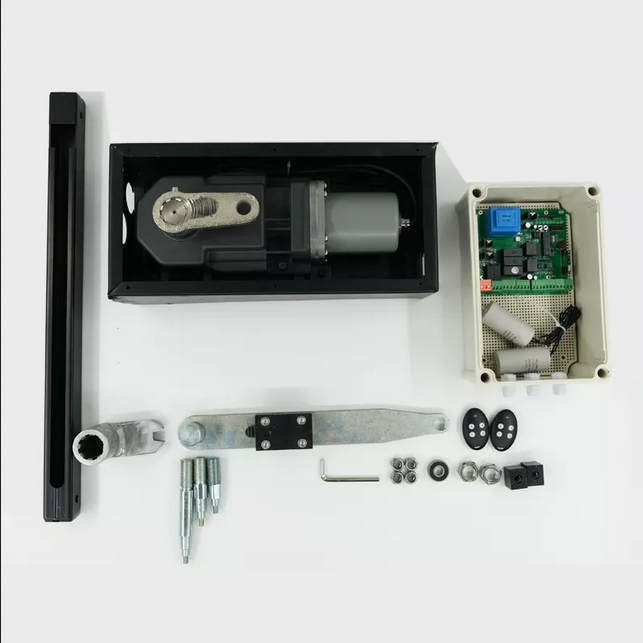Ever had to think twice about leaving your car’s safety to open your gate at night? Or, do you have kids and pets that play around the house and you want to keep them safe and within sight?
Then, you need an automatic gate operator, and if you’re in the business of selling gates, your customers need them too.
Automatic gate operators automatically control gates on command for authorized access. They are secure and convenient and spare users the hassle of manually opening gates themselves or having someone else do so.
This article discusses all you need to know about selecting the right automatic gate operator to boost sales.
Table of Contents
Automatic gate operators: market growth and demand
Tips for selecting automatic gate operators
Other considerations for choosing automatic gate operators
Key takeaways
Automatic gate operators: market growth and demand
The increasing necessity for convenience and safety intensifies the demand for automatic gate operators. That aside, there’s also the lifestyle appeal and value it gives a property.
One can install these gate operators at any real estate — family homes and industrial areas, giving your business more opportunity to increase sales.
According to this study, the automatic gate operator market will reach US $6.34 billion in 2032, growing at a compound annual growth rate (CAGR) of 7.5%. This is because key players invest more in technological advancements, thus expanding the market.
There are also increasing security standards due to AI integration into security gates. These innovations are bringing more players into the market, increasing investment, and causing the market to thrive.
Tips for selecting automatic gate operators
You might not know where to start when choosing the right gate operators that meet customers’ needs. Don’t worry; the following are things to consider to maximize profit:
1. Gate type
The type of gate at the entry is the first thing to consider when choosing an automatic gate operator. Does your gate swing or slide open? Is it a large vehicle controlling access?
Consider the following gate types:
Swing gates
Swing gates require low maintenance but more space to operate than slide gates because they rotate on a pin to open inward and outward. They’re also easy to install, and you can include railheads at the top for improved customer security.
Depending on the opening size, you might need a single or a double swing gate. Their controls allow you to open one or both gates at once. Double swing gates need two mechanisms on each side of the doors and are more expensive.
Slide gates
Slide gates move sideways along a track to allow entry and require less space. They’ve got wheels on the bottom that run on a track fixed in the ground, while a motor pushes it.
These gates have a minimalist look but need more maintenance than swing gates. However, they’re secure, sturdy, and aesthetically pleasing.
2. Types of automatic gate operators
Different types of gates need various kinds of openers to make them automatic. To choose the right gate operator for suitable gates, consider the following:
Articulated gate operator
The articulated gate operator, also known as the “crank arm operator,” has a motor that controls a hinged arm. One arm is attached to a post or pillar, while the other arm attaches to the gate. When in use, the motor pulls the jointed arm together, which opens the gate or expands to close it.
Customers can easily install articulated gate operators because they are versatile and can open most types of swing gates. They also require little maintenance.
Therefore, offer it as an option to customers looking for something suitable for high-traffic environments like warehouses or gated communities.
Underground gate operator
You can install underground gate operators in the ground. These types of gate operators are kept inside a protective box, and the drive arm is connected to the bottom of the gate.
Gates with underground operators are elegant because the motors are not visible, preventing a tacky look. They are also very quiet, making it best for customers concerned about noise.

The installation process is complex and expensive. Though the motors are in underground boxes, they might fill up with water, making them prone to corrosion.
You can use underground motors/operators for swing gates.
Sliding gate operator
A sliding gate operator uses a tooth and cog action attached to the gate to open it in the desired direction. You must combine it with a guide track, roller guides, or cantilever device to open to your preferred direction.
They are ideal for customers with short driveways or if the driveway behind the gate is on a high slope.
Sliding gate operators are common in commercial gates with cantilever gate systems. A cantilever gate system allows the gate to hang off the ground while using two gate posts for support.
3. Power source
Automatic gate operators use various sources to power the gate. Solar-powered gate operators need about eight hours of sunlight to charge the battery. The stored energy allows it to run at night and on cloudy days.

An average solar-powered operator opens 8–10 times a day, so if customers will use it more frequently, have them consider another backup power source or an electric gate operator.
If customers prefer an electric gate operator, ensure it has a backup battery because the gate could get stuck open or closed during a power outage. Hence, they’ll need wiring to connect them to electricity, which may be impractical for properties that don’t have AC power near the gate.
Other considerations for choosing automatic gate operators
Although convenience is a major factor for installing automatic gate operators, there are other considerations regarding customers that you should keep in mind to increase sales; these include:
Customer preferences
Some customers may want someone to secure the gates but easily open it with a button. Others might want to do so themselves, but remotely using a mobile app control. In that case, both kinds of customers will need an automatic gate operator with an intercom for communication.
You may also want to include various sensors to your catalog for customers who need an added sense of security. Though all automatic gate operators have sensors, your customer might require an upgrade depending on their intended use.
For instance, customers with kids or pets might prefer gate operators with optical or motion sensors to detect movement from playing kids while it’s closing.
Other sensors to stock up on include radar movement sensors, active infrared sensors, passive infrared movement sensors, and pressure sensors.
Environmental influence
You can install automatic gate operators in almost all kinds of gates, from small pedestrians to large vehicle gates. But the kind of operators installed depends on the traffic at the entryway.
If customers want automatic gate operators in single-family homes, consider an easy-to-operate yet effective system because they’ll likely not use it frequently. However, for customers installing their gates at high-traffic commercial areas, apartment buildings, or estates, consider offering them, heavy-duty gate operators. These gate operators are also ideal for heavy or large gates.
Key takeaways
As a business, you must provide customers with the right automatic gate operators by factoring in environmental influence, use, and preferences.
You can always have customers choose from the various gate operator models available. Still, it’s in your best interest and theirs to follow the tips outlined in this article to make the best selection.



